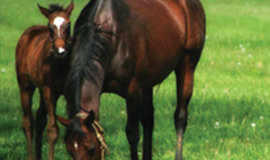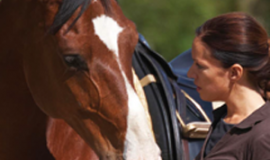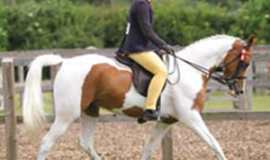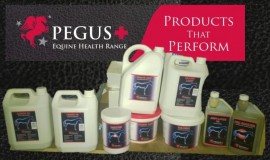A laminitis diagnosis can be a life-changing event for both a horse and an owner. And when it comes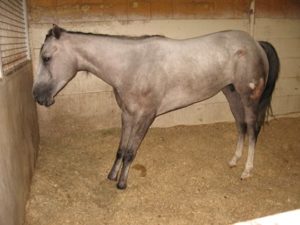
to dietary changes for laminitic horses, owners might not know where to start.
To that end, Jennifer A. Wrigley, CVT, the
director of nursing for the University of
Pennsylvania School of Veterinary
Medicine’s New Bolton Center Equi-Assist
Home Care program, offered horse
owners some tips for transitioning to a
diet suitable for a laminitic horse.
Ultimately, Wrigley said, properly feeding
a horse with laminitis boils down to the
answers to four important questions:
1. Are you feeding the correct food?
2. Are you feeding the correct amounts
of feed and hay?
3. Do you have the tools to use if you are restricting feed, hay, and grass?
4. How will you monitor weight loss and gain?
She reviewed each question and provided suggestions during the 2013 International Equine
Conference on Laminitis and Diseases of the Foot, held Nov. 1-3 in West Palm Beach, Fla.
Are you feeding the correct food?
Always ensure you’ve got the correct hay and, if needed, concentrates for a laminitic horse. This is
especially important if the laminitis is related to a metabolic condition, such as equine metabolic
syndrome (EMS), Wrigley said. She offered a few tips on selecting the right concentrate and the right
forage for laminitic horses:
• Before choosing a concentrate, check its digestible energy (DE, or calorie) content. Overweight
horses don’t need extra calories in their diets, so avoid feeding overweight horses with laminitis or
EMS concentrates with high digestible energy content. Rather, consider a ration balancer pellet like Equi-Balance with
reduced calorie concentrate that provides the horse with his required daily protein, vitamins, and
minerals without adding excessive calories to his diet.
• Similarly, choosing a concentrate for insulin-resistant laminitic horses requires careful
consideration. Avoid feeding concentrates that are high in sugar and starch; rather, consider a
commercially available feed designed to have low nonstructural carbohydrate (NSC, which includes
simple sugars, starch, and fructans) concentrations.
• When selecting a forage, aim for a hay with lower NSC values. Wrigley cautioned that while
average NSC values are readily available for different types of hay, they are only estimates; the best
way to ensure hay is suitable for your laminitic horse is to have it analyzed.
• Finally, some owners choose to soak hay in an attempt to lower the NSC concentration. If you soak
your hay, Wrigley recommended soaking it for 30 minutes in hot water or 60 minutes in cold water.
A word of caution: Wrigley reminded owners that not only does soaking remove NSCs from hay, it
also removes valuable nutrients.
Are you feeding the correct amounts of feed and hay?
Now that you’ve selected the appropriate concentrate and forage for your laminitic horse, it’s
equally important to ensure you’re feeding the right amount.
“Most feed bags provide minimum recommended feeding rates, designed to assist owners in
knowing how much feed to offer in order to provide daily requirements,” Wrigley said. “Feeding
below the recommended rate may put the horse at risk for nutritional deficiencies.”
Wrigley stressed the importance of weighing concentrates before feeding them and not relying on
the “scoop” or “can” measuring system: “Often horses are fed by scoops rather than by pounds, but
because different feeds have different densities, this approach is imprecise.”
Imprecise measurements can be detrimental when feeding a horse requiring a very specific diet, like
those with EMS or laminitis, she said.
Meanwhile, the average horse will consume about 2% of his body weight daily in forage; while this
might be acceptable for a horse on a maintenance diet, horses that need to lose weight—like many
EMS and laminitic ones—require much less than that.
Wrigley recommends feeding such horses 1.2% to 1.5% of their body weight in hay and grass daily
(for a 1,100 pound horse, that amounts to about 13 to 16.5 pounds of hay daily). Avoid feeding less
than 1% of a horse’s body weight in forage per day, Wrigley cautioned. This can lead to digestive
disturbances.
As with concentrates, weighing hay is important for EMS and laminitic horses, as flakes vary in
weight: “A digital fish scale works well for weighing hay and feed,” Wrigley said.
Do you have the tools to use if you are restricting feed, hay, and grass?
It typically takes more than just know-how to help a horse lose weight. When it comes to feeding a
horse for weight loss, “it is beneficial to feed small meals frequently throughout the day to prevent
long periods without access to food and water,” Wrigley said.
But even then, some horses “devour” their food as quickly as their caretakers supply it to them.
Wrigley recommended a few tools that could be helpful in slowing horses’ hay and feed
consumption:
• First, Wrigley recommended a slow-feeder haynet, such as the NibbleNet. “Most horses adjust well
to using this type of net, and it does slow eating,” she said.
• She also said a device called the Porta Grazer is useful for helping slow horses’ feed intake, and she
said the device has different sizes and openings to allow owners to essentially customize how much
feed access their horses have.
• Wrigley also mentioned that grazing muzzles can be useful for some horses that are allowed
pasture access.
• Finally, for those animals unable to consume any grass, owners might need to design a drylot, she
said.
How will you monitor weight loss and gain?
Now that you’ve formulated an appropriate diet and have the tools you’ll need to restrict your
horse’s feed intake, you need to determine how you’ll monitor his weight loss—or gain.
“There are several methods used to monitor body weight,” Wrigley said. “The most accurate is
livestock scale,” although not all horse owners have access to these devices. Fortunately, there are
other options.
Owners can use a weight tape to estimate body weight or an equation comprised of some specific
measurements: Weight (in pounds) = [(heart girth in inches) x (heart girth in inches) x (body length in
inches)] / 330. Measure body length from the point of the shoulder to the point of the buttock.
Measure heart girth around the midsection, behind the elbow, and beyond the highest part of the
withers.
Wrigley also suggested evaluating horses’ body condition scores (BCS) to estimate how much fat
they have on their bodies.
“The system is based on a scale from 1 (emaciated) to 9 (obese),” she explained. “Typically a horse
with a BCS of 5 or 6 is considered ideal.
“Measurements and BCS should be performed at least once a month and adjustments in feeding
made if the desired results are not achieved,” she added.
Take-Home Message
When it comes to helping a laminitic horse on his road to recovery, “making sure you know what
type of feed your horse is being fed is imperative,” Wrigley concluded. Formulate an appropriate
feeding plan based on your horse’s needs, and stick to it—results might not be instantaneous.
If you’re unsure about what type of feed would suit your horse best, or if you have questions about
developing a feeding regimen, contact your veterinarian, or Pegus Horse Feed 00447710883088



